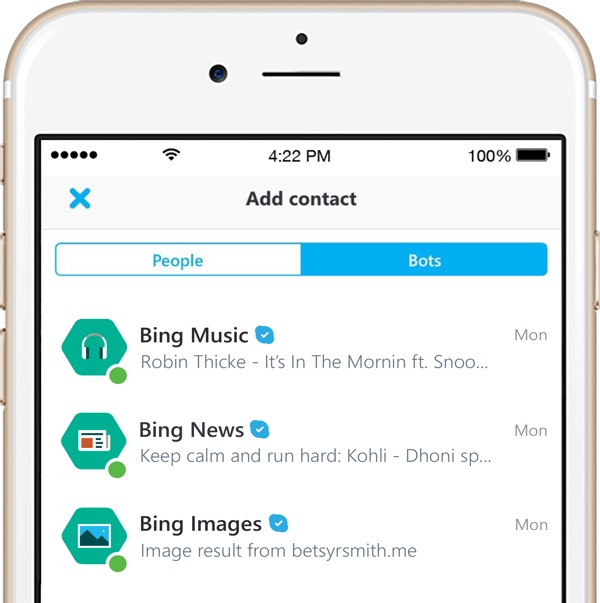Social Media meets Bots and Artificial Intelligence

You may have seen today’s Chat Bots announcement for the Facebook platform for the Facebook f8 conference. Last week saw Microsoft’s CEO declare bots as the next big thing, with the company creating a platform for the creation of bots on other platforms, including its own Skype Instant Messenger channel.
So what ARE bots? Broadly speaking, a bot is software that runs automated tasks over the Internet – you could create a bot that watches your Facebook status and automatically posts that status on your Twitter feed, for example. The service ifttt.com enables you to create such bots. A chat bot is a different beast entirely, and an intelligent chat bot is different again.
The recent popularity of chat bots owes to the fact that a great number of people are spending a good deal of their time in Instant Messaging platforms, chatting with friends, privately debating, even playing games. Facebook just announced 900m monthly users on Messenger with 60billion messages sent every single month. Below are examples of simple bots shown through Facebook Messenger and Skype IM, currently launched on a Beta basis.


So, what’s the plan, Stan?
The idea behind chat bots is that a user can activate a game of chess (or similar) in mid conversation with a friend, and then intersperse their gaming with their personal chat. It’s not quite sitting in your living room, playing a game with a cup of tea, but the boundaries are getting fuzzier.
The more interesting chat bot technology will algorithmically learn based on instructions taught to it, and interacts with users using natural language. Bots learn to understand what you write. You probably saw the recent stories of Microsoft’s Bot running riot on Twitter after it automatically adopted racist behaviours from users. Whilst this bot became quite offensive and had to be taken off the shelf, the achievement was significant, and it’s why the likes of Microsoft’s CEO is hailing bots as the next big thing. We agree. The recent announcements by Skype and Facebook along with the likes of Kik Messenger and Line, and the opening of IM platforms to third-party services, herald the start of a boom that parallels the arrival of smartphone apps.
Intelligent chat bots provide an intuitive and de-parameterised user experience in which transactions can be made whilst on the move with a mobile phone. The premise is simple, an intelligent chat bot doesn’t require you to book a hotel and get all of the variables right or ask for the hotel using a geeky language. If you miss something important, like the check in date, it simply asks you or even makes an assumption that you’re talking about tonight – a bit like a human hotel receptionist. You could message an intelligent hotel bot in the same way you’d message a friend, and it will understand you via its very nifty artificial intelligence engine.
So what makes all this relevant to social media? Well the answer is in the social aspect of chat bots. Most social networks offer Instant Messaging channels, and with a billion users, shows us that it’s where people hang out. If large numbers of users spend time in a messaging platform, then the owners of that platform will naturally try to figure out how to monetise that activity. Yes, advertising is an obvious method, but a more meaningful and less intrusive activity is supporting commerce transactions – enter, Instant Messaging Commerce, known as ‘Conversational Commerce’.
The AI takes care of all of the tedious detail for you
Conversational Commerce allows you to do anything that’s possible with an app, such as ordering a taxi, only through a text-based interface. But don’t be afraid of any tedious associated activities such as having to specify ‘pickup’ and ‘destination; worrying about spelling errors and or writing in code or a particular format. None of that will matter if you order an uber car using Conversational Commerce, for example.
That’s the beauty of this type of social intelligence. The AI takes care of all of the tedious detail for you, recognising what you want to do from a normal textual dialogue, like “I wanna grab a cab from my house to the airport”. Easy. It knows you’re talking about home, knows where you live, and knows that you want to go to the airport. And it’ll assume it’s the local major airport. Now imagine the possibilities, and you’ll see why everyone’s getting so excited about it. It’s like Siri on Steroids, and as a bonus, nobody gets to hear you clumsily and repeatedly speaking out loud into your phone like you’ve gone clinically insane.
Imagine a world where you can just ask, “can I get my usual pizza delivered now please”, or “can you pick up my laundry and take my dog for a walk” or even, “can I order a repeat prescription”. Conversational Commerce suits on-demand services because of the frictionless way in which users can activate a commerce instruction. Well, if you embrace the future of technology, you’ll be excited to know that it’s a world that’s not so far away, especially with the major platforms opening their doors to allow software developers to create intelligent bots. And where is that channel best located? Why, in your pocket, of course. On your mobile phone.
The technology potential is enormous
And let’s take the concept just a little further and talk to the social nature of the technology. Imagine being able to order that taxi you wanted while you’re in the middle of a chat with a friend, with the chat bot monitoring your conversation arranging to meet. Or perhaps you want to order a birthday present for someone after suddenly realising it’s their birthday when chatting, or buying something your friend is recommending to you (before you forget). All of a sudden, we have social shopping, performed in an intimate, natural manner. The technology potential is enormous, providing for interwoven conversations with information about items plucked off the web using an AI chat bot, “Are these the shoes you had on yesterday?”, or “Do you want this for your b-day? I’ll order it now!”, or “I was drinking this whisky last night, it’s amazing.” The opportunities presented from social conversational commerce over social media are significant.
Finally, there’s no reason why this bot technology needs to interact solely with just text. Not only can a bot send you a picture of the hotel you’re thinking of, or the taxi rating and a picture of your driver, but it can send you video – and video now can be made interactive. Skype’s new APIs available through Microsoft’s Cognitive Services are offering some very wizzy functionality, and it won’t be long before you can ask to change the colour of a clothing item worn by a catwalk model you’re watching on your phone through video. And why not check into a physical store by simply sending a message. Your phone will be doing it all – and probably just using a single app, an IM Messenger.
So watch out for Conversational Commerce. It’s coming, strong and hard, and it’s going to get VERY social. It won’t replace our standard high street nor our eCommerce experiences, but it’ll add to the mix, and make the buying experience richer and potentially more fun.

